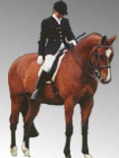 |
classicaldressagescotland.com |
| Modern competition dressage |
| New web address: www.classicaldressagescotland.com |  |
| About this site | About us | Personal Tuition | Video analysis | Lessons | Portugal and Lusitanos |
| Home Schooling Classical dressage Modern dressage Horse trials Show jumping Glossary Links |
Dressage is simply the training of the horse
- training him to use his body with the suppleness and control
of a gymnast, the grace and lightness of a ballet dancer. The
rider must learn to control and master the techniques to supple
and develop the muscles the horse needs to perform the increasingly
difficult movements. The rider has to win the horse's co-operation
and respect so that they can work together in harmony.
For three hundred years the aristocrats of
Europe spent most of their time on horseback, learning how to
make horses go sideways, to leap in the air on command and to
show off these activities in extravagant equestrian pageants
and carousels. Riding Masters on the Continent, especially in
France, many of whom became court favourites, gradually evolved
a logical series of steps for converting the untrained horse
into an equine gymnast over a period of three or four years.
Fortunately they discovered, too, that any reluctance to perform
the complicated movements was not due to truculence and disobedience,
which they would attempt to cure with sharp spurs, a long whip
and atrociously severe bits, but to a lack of ability, muscle
development, confusion and a failure to understand. Gradually
the horsemasters found ways of training horses by encouraging
co-operation rather than threatening punishment. These humane
methods of training have changed little over the last hundred
years, but what has changed is the outlet for training and improvement.
Whereas the end products of dressage training were used in public displays, including the circus, they are now, in line with the modern fashion, used to compete against others. Although there are hundreds if not thousands of small dressage competitions being held all over the world the standards of riding and training took and great leap forward with the introduction of dressage in the 1912 Stockholm Olympic games. Dressage is now an integral part of the horse competition scene along with show jumping, one and three day event riding (military) and carriage driving. As with other sports, participation at the Olympic Games became such an all-consuming goal for athletes that standards rose rapidly; the dressage tests became more and more difficult (piaffe and passage were first asked for at the 1936 Games). Today it has been recognised that a good grounding and preparation in both training and competition must be encouraged at grass roots level to produce the Olympic superstars of the future. It has also been recognised, especially in the last fifty years, that many riders who have no aspirations to join the elite at the Olympic Games still want to enjoy dressage. They like to compete just for the sake of competing, and training their horses up to the standards that they can afford bearing in mind both time and money. In most countries in the world there is a local organisation controlling the administration of dressage helped and guided by the F.E.I. And in most countries there are local clubs and associations holding training sessions and competitions for their members. Each and every organisation has its own rules and guidelines but the basic premise is there - to improve the levels of training and performance in competition. Its has also been found in recent years that young horses destined for a career in show jumping or eventing will benefit from a grounding in dressage training and dressage competition. In the United Kingdom the levels of competition are divided into two categories, national and international and subdivisions of those categories. Each level of test has its own movements to perform reflecting the standard of training and expertise of both horse and rider at that level. Preliminary is the easiest, Grand Prix Special the most advanced. National Level
World Wide Classical and Competition Dressage, in the lessons to come, will teach you to train, prepare and compete and also teach you some of the tricks of the trade in modern dressage. We can also help you with your music (for a small extra charge because it can take some time) for your competition and from a video, suggest rhythms, tempos and styles of music for your horse. We will also help you interpret those confusing judges remarks on your dressage score sheet and put what they saw into practise so you don't make the same mistakes again. |